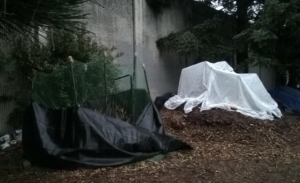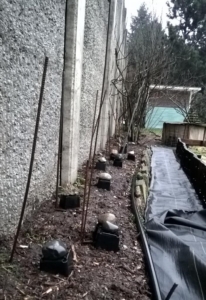FECO Native Plant Mini-nursery Socked by ‘Dry Storm’
April 7 is our annual plant sale and we plan to have some fine offerings, that is, if the plants survive the recent dry freeze.
These last two weeks of unusual Seattle weather challenged many plants. The air over our area has been extraordinarily dry, due to the frigid low-moisture Arctic air that moved in. Relative humidity dropped, with values below 40%, and the dew point was near zero! Temperatures from January 12 through January 14 did not rise above 32ºF. To boot, some plants may not have hardened off well for winter acclimation, since temperatures prior to this cold spell were warm.
Temperatures have eased and Seattle has returned to rain. After the storm, I studied up on the impact of a freeze on container plants, and how the nursery pros prepare.
for work parties
Please email to volunteer
freewayestatescommunityorchard@gmail
Preparation of outdoor container plants for freezing temperatures is challenging. A big concern is root damage, especially since the newer feeder roots tend to develop near the edge of the pots. Low temperatures can cause root damage but perhaps a greater risk is lack of moisture within the planting medium (different mixes of soil, compost, sand, coir, and fine chips).
When freezing temperatures are in the forecast, container plants need to be watered and then protected from sun and wind. Moving plants close together and mulching around the perimeter of the pots with newspaper, pine needles, leaves or some other composted material is a good start.
Winter desiccation (drying out) causes more plant loss than freeze injury in unprotected nursery stock. If the soil or planting medium freezes, no moisture is available to leaves, shoots or roots. Plants can be killed by desiccation even if temperatures are not low enough to kill them otherwise. Watering plants before a freeze allows plants to store water.
Draping some lightweight covering over the plants will reduce wind damage and can hold onto a bit of the heat and moisture from the soil. Alternative materials to plastic coverings include cotton, wool, and burlap.
Tucking plants into the shade is also beneficial. The shade protects the leaves of evergreens from sun and wind,  reducing water loss on bright, cold days. Shade also minimizes temperature fluctuations in the winter. Be sure to open up your protective layer as temperatures rise above freezing. Otherwise, heat may build up under the fabric which could cause plants to break dormancy too early. After you remove the protective layer, plants should be shaded for several weeks to prevent sun scald.
reducing water loss on bright, cold days. Shade also minimizes temperature fluctuations in the winter. Be sure to open up your protective layer as temperatures rise above freezing. Otherwise, heat may build up under the fabric which could cause plants to break dormancy too early. After you remove the protective layer, plants should be shaded for several weeks to prevent sun scald.
Symptoms for most plant damage will not show up until the plant becomes more active in the spring.
The response of roots to physical damage is wood browning. (It helps if you know what healthy roots look like!) Many times, plants with significant damage to roots will appear to grow normally in the spring but die quickly under the first period of elevated temperatures, high sunlight and low humidity conditions.
Woulda, coulda, shoulda! How close did we come to matching these protocols? Just before the temperatures  dropped, three volunteers dug the small potted plants into the big chip pile, which always has some warmth due to mighty microbial metabolism. We draped row cover over the plants in the chip pile and added straw and leaf mulch over and around other vulnerable plants. Sue had already plopped plant pots over her dahlia bulbs. We didn’t water prior to the protection and we hope the plants were sufficiently hydrated from rain prior to the storm.
dropped, three volunteers dug the small potted plants into the big chip pile, which always has some warmth due to mighty microbial metabolism. We draped row cover over the plants in the chip pile and added straw and leaf mulch over and around other vulnerable plants. Sue had already plopped plant pots over her dahlia bulbs. We didn’t water prior to the protection and we hope the plants were sufficiently hydrated from rain prior to the storm.
Very soon we will take off the row cover at our little outdoor nursery and look at the faces of the little darlings. As they look back at our faces, may our expressions reflect hope!
Ruth
Resources:
Clif Mass Weather Blog
https://cliffmass.blogspot.com/2024/
Nursery manual for native plants: A guide for tribal nurseries – Volume 1 (USFS)
https://www.fs.usda.gov/rm/pubs_series/wo/wo_ah730/wo_ah730_229_245.pdf
Management of Container Nursery Plant Material During Cold Weather (Rutgers)
https://njaes.rutgers.edu/fs528/
Preparing Nursery Plants for Winter (NC State Extension)
https://content.ces.ncsu.edu/preparing-nursery-plants-for-winter



I enjoyed reading this! It inspired me to try and be more proactive myself next time we have some tough weather.